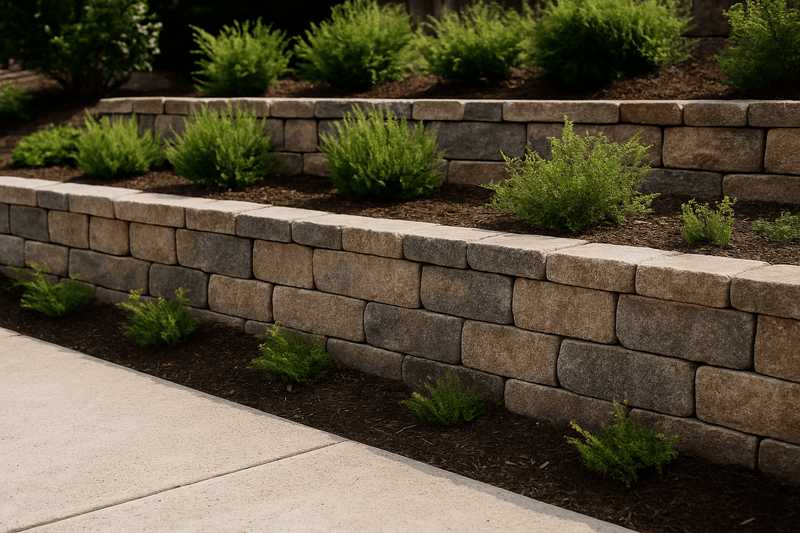
Across the Macarthur region, more homeowners and developers are discovering that retaining walls do more than hold back soil. Done properly, they can transform unusable land into beautiful, functional spaces. They control water flow, protect foundations, and add definition to outdoor areas—turning what was once a sloped, underutilised space into tiered gardens, patios, or driveways.
Whether you're in Campbelltown, Camden, or the surrounding suburbs, retaining walls in Macarthur are becoming a staple of smart landscape design. But before you call in the machinery, it pays to understand the purpose, design options, legal considerations, and who you can trust to do the job right.
The Functional Role of Retaining Walls in Macarthur Landscapes
The geography of Macarthur presents unique challenges. Undulating land, seasonal storms, and expanding developments all contribute to increased demand for structural landscaping solutions. Retaining walls provide an effective way to stabilise sloping ground and prevent erosion. They help manage water runoff and create level areas for lawns, garden beds, and outdoor living.
More than just functional, retaining walls can be a key visual element. From rendered block walls that match a modern façade to natural sandstone features that blend with the landscape, the choice of materials can greatly influence curb appeal and long-term usability.
Most importantly, retaining walls protect your property. Poor drainage and shifting soil can place pressure on home foundations, fences, and driveways. Professionally constructed walls relieve this pressure by supporting the land and directing water where it won’t cause damage.
Do You Need Approval for Retaining Walls?
One of the biggest mistakes homeowners make is assuming they can install any wall without consulting local council regulations. In Macarthur, the height, material, and intended purpose of the retaining wall determine whether approval is required.
As a general guide, walls under 600mm high without a load above them (like a fence or building) may not require approval. However, if the wall is over this height, supports a structure, or alters drainage patterns, development approval is likely needed. Ignoring this step can lead to costly rectification works.
That’s why working with experienced providers like Retaining Walls Macarthur by Waynes Landscaping is so important. They not only build to engineering standards but also understand how to manage approval processes, drainage plans, and soil reports.
Choosing the Right Materials for Your Site and Style
Material choice can make or break the appearance and lifespan of your retaining wall. Timber sleepers are affordable and quick to install but may weather over time. Concrete blocks offer clean lines and uniform strength. Natural stone brings a timeless, organic feel—perfect for bushland or garden-heavy properties. Brick, although less common, is sometimes used to match existing structures.
Selecting the right material isn’t just about looks. It must also suit the site’s soil type, gradient, drainage demands, and intended use. For instance, a high-traffic retaining wall near a driveway might require reinforced concrete or interlocking block systems. Meanwhile, a low, decorative wall around a garden could be made from treated pine or sandstone.
Understanding the context of your block and future landscaping goals is essential. Teams like those behind professional services for retaining walls Macarthur bring both design flair and engineering knowledge to the table, ensuring your wall lasts and enhances your outdoor space.
Drainage: The Hidden Hero of Every Retaining Wall
One of the most underestimated aspects of retaining wall construction is drainage. A wall might look solid on the outside, but if water builds up behind it, pressure increases rapidly—leading to bowing, cracking, or complete failure.
This is especially relevant in Macarthur, where seasonal storms can deliver intense rainfall. Proper drainage involves using gravel backfill, agricultural pipes, and weep holes to ensure water escapes freely. The soil behind the wall must also be compacted correctly to avoid future settlement or erosion.
When comparing quotes or talking to contractors, always ask how they plan to manage drainage. If it’s not mentioned, that’s a red flag.
If you're keen to learn more about how landscape construction integrates with water management, take a look at this breakdown on Friendza Enroles covering water-smart design.
Integrating Retaining Walls into Broader Landscape Plans
Retaining walls shouldn’t exist in isolation. The most successful projects are part of an overall plan that includes planting zones, lighting, paving, seating, and outdoor structures.
You might use a tiered retaining wall to separate functional zones—a vegetable garden on one level, a fire pit or lawn on another. Some homeowners integrate garden beds directly into the face of the wall, creating green walls that are as useful as they are beautiful.
Walls can also act as backdrops for privacy screens, vertical gardens, or even cascading water features. With the right team, you’re not just solving a slope problem—you’re elevating the entire landscape design.
If you’re unsure how to begin visualising the space, this guide on Friendza Enroles offers useful starting points for terraced garden layouts and retaining wall configurations.
Why Local Expertise Matters
Macarthur’s soils, council rules, and development trends are unique. Hiring a contractor from outside the region may result in generalised solutions that overlook important local nuances. A wall that performs well in one suburb may struggle in another due to clay soils, underground water flow, or site access challenges.
Choosing a team with on-the-ground experience in Macarthur gives you peace of mind. They understand common soil types, council preferences, and how local weather affects construction timelines.
Providers like Retaining Walls Macarthur by Waynes Landscaping combine this local knowledge with quality materials and a practical design focus, ensuring each project runs smoothly from planning to finish.
When Is the Right Time to Build?
Retaining wall construction can take place at almost any time of year, but drier months are generally ideal. Winter and early spring may be more cost-effective, as demand is often lower. However, urgent drainage or erosion issues should be addressed as soon as possible, regardless of season.
If you’re planning a larger landscaping project—such as a pool, outdoor living area, or garden redesign—it’s wise to schedule retaining wall works early in the process. These structures often form the foundation of your outdoor space, so they need to be in place before other elements can be added.
Final Thoughts: Retaining Walls Are an Investment in Stability and Style
Whether you’re dealing with a sloped yard, poor drainage, or simply want to add structure to your garden, a retaining wall is often the missing link. But like any structural addition, success depends on more than just digging and stacking—it comes down to thoughtful design, the right materials, and expert execution.
With the help of seasoned professionals like professional services for retaining walls Macarthur, you can build a wall that supports not just soil—but your entire landscape vision.




